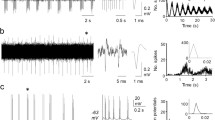Abstract
After recording rhythmic discharges in the ventral spinal roots Perret and co-workers postulated the existence of a special “locomotor pacemaker”. The present writers showed that the “locomotor discharges” discovered by Perret and co-workers increase during asphyxia and disappear during apnea. Rhythmic discharges in the ventral roots thus depend on the irradiation of excitation from the respiratory center and they cannot be evidence of the existence of a special locomotor pacemaker.
Similar content being viewed by others
Literature Cited
L. A. Orbeli, Lectures on Physiology of the Nervous System [in Russian], Leningrad (1935).
C. Perret, M. Mullenvage, et al., J. Physiol. (Paris)65, No. 1, 153A (1972).
Rights and permissions
About this article
Cite this article
Lisin, V.V., sergeeva, L.N. & Frankshtein, S.I. Nature of rhythmic discharges in ventral spinal roots. Bull Exp Biol Med 80, 1410–1411 (1975). https://doi.org/10.1007/BF00842622
Received:
Issue Date:
DOI: https://doi.org/10.1007/BF00842622




